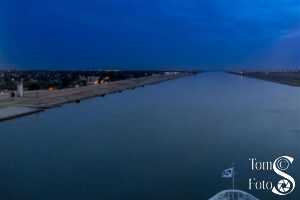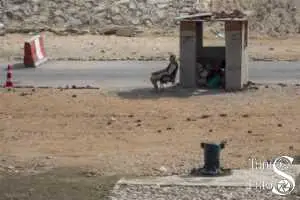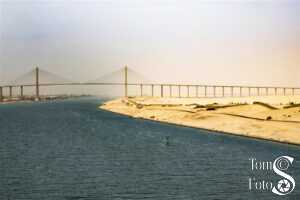The Suez Canal is another one of those special spots where you can stand on the deck of a ship and see two continents just by turning your head. Even though both sides technically belong to Egypt, for a northbound transit looking to the left you see Africa and looking to the right you see Asia.
The canal is transited in convoys with both north and southbound convoys starting about the same time: 5am. The number of ships varies but generally runs about 25 or so for each direction. In the past, the two convoys had to both reach the Bitter Lakes and cross there but now that a second channel has been dug north of the Bitter Lakes the meeting of the convoys generally takes place at some point in the two channel section of the canal.
The Red Sea is a tiny bit higher than the Mediterranean (tidal forces are generally larger closer to the Equator). The initial worry was that invasive species would migrate from the Red Sea into the Mediterranean. At the start, the higher salt content in the Bitter Lakes prevented this migration but since the canal opening in 1869 the salt level in the Bitter Lakes has diminished and some migration has started. Expect that to continue with the eastern Mediterranean being changed by the more aggressive Red Sea species.
We arrived at the southern end of the canal the night before our scheduled transit and anchored. Later in the evening we pulled the anchor and moved closer to the canal entrance as we were to be the first in our convoy. We found out later that there is a priority given to the type of ship. Military ships are always first, passenger ships follow, and cargo ships take the last positions based on weight with the heavier ones that need a tug to help them being last.
About 4:45 we started to move and entered the canal at 5am the next day. Of course, the sun was not up so we did not see the exact entrance but it was clear we were in a canal as the sun rose and we saw the developed side (the African side) and the largely sand side (the Sinai). We sailed the distance (about 150 km) at 8.5 knots. We could not go any faster because that would have created a wake that would erode the sides of the canal as it’s basically just a ditch in the sand.
Along the way there were periodic guard stands and military outposts. Some of the guards did not mind photos being taken of them but others went into their post and closed the door as we approached. This was particularly true as they saw with their binoculars several of us with long lenses on our cameras up on the top deck.
The day started cool but quickly heated up as we continued our course. Before the canal we had the Red Sea to temper the heat but in the canal we might as well have been on land. It got up to 95 degrees (35C) at the hottest point. And, we had some breeze so the sand was being blown and the photos taken were all hazy so the sea day that followed was spent editing the haze out of the photos as best possible.
When we got to the Mediterranean end of the canal about 4pm we hit a wall of colder air shortly after leaving the canal and the weather changed almost immediately. The sea became quite rough (four meter swells) and we went back into rock and roll mode; something we stopped doing after rounding Australia and proceeding through the Indian Ocean and Red Sea. Also, we started to need jackets up on deck. A real change.
I’ve included three photos from the canal transit: an early morning shot from the front of the ship, a cooperative guard, and the Japan-Egypt Friendship Bridge which I have taken to calling the bridge from somewhere to nowhere as even though completed in 2001 we saw no traffic on it despite the large city on the African side of the canal in Egypt. The Sinai side has no development. Plus, directly under the bridge there is a ferry service that takes people to the road by the canal; with the bridge you have to drive a considerable distance on the bridge before you can get off.
With nothing to be seen on the schedule that’s where I stopped taking photos and went back inside to the air conditioned spaces of the ship. Had enough of the heat and sand. As I write this even after a day at sea I’m still sneezing sand; I hear others doing the same.


